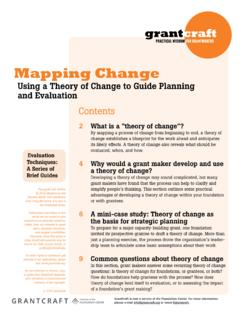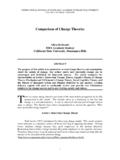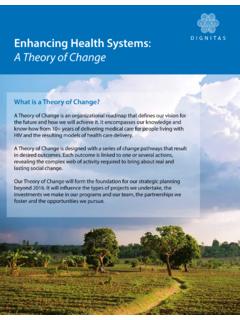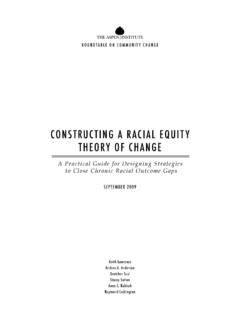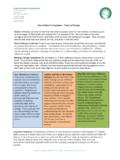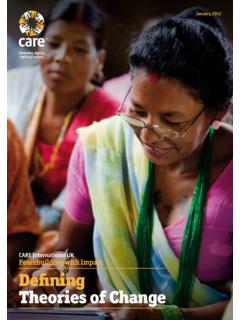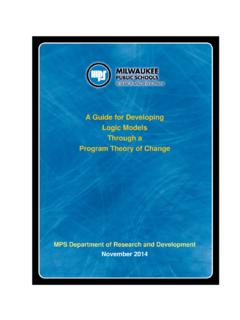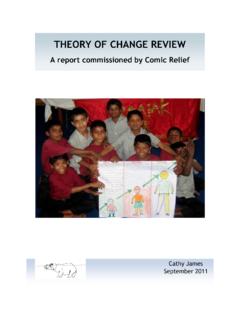Transcription of The Community Builder’s Approach to Theory of Change
1 ROUNDTABLE ON Community CHANGEA ndrea A. Anderson, Community Builder s Approach toA PRACTICAL GUIDE TO Theory DEVELOPMENTT heory of ChangeFor more information about the Community Builder s Approach to Theory of Change , visit or contact Andrea Anderson at:The Aspen Institute Roundtable on Community Change281 Park Avenue South, Fifth FloorNew York, NY 10010212-677-5510 One: Theory Development Introduction .. 1 What Is the Community Builder s Approach to Theory of Change ?.. 3 Before the Meeting: A Step-by-Step Guide for Facilitators..11 In the Meeting: Practical Information for Facilitators ..17 Conclusion ..27 Section Two: Resource Toolbox Case Study: Project Superwoman.
2 31 Suggested Materials..34 Suggested Participants List..34 Glossary..35 PowerPoint Presentations and Training Materials ..36 Section One: Theory DevelopmentTheory Development Introduction1theory of Change can be a helpful tool for developing solutions to complex social problems. At its most basic, a Theory of Change explains how a group of early and intermediate accomplishments sets the stage for producing long-range results. A more complete Theory of Change articulates the assumptions about the process through which Change will occur, and specifies the ways in which all of the required early and intermediate outcomes related to achieving the desired long-term Change will be brought about and documented as they occur.
3 To best realize the value of creating a Theory of Change as part of planning and evaluating social interventions, the Aspen Institute Roundtable on Community Change (Roundtable) developed an Approach to help Community builders create the most robust theories of Change Community Builder s Approach to Theory of Change : A Practical Guide to Theory Development is for planners and evaluators who are going to facilitate a process for creating a Theory of Change with Community -based programs and Community Change initiatives. It was designed as a refresher course for planners, evaluators, and others who have attended one of the Roundtable s Theory of Change Workshops,2 but we fully expect experienced facilitators will be able to quickly learn and apply the method as described in this guide.
4 Please visit our web site, , for updated information and additional OF THIS GUIDE We ve organized this guide into two sections. Section One answers the question What is a Theory of Change ? It provides all the information needed to facilitate a Theory of Change process with a Community group. This section reviews the major concepts that define theories of Change ; provides important background information for facilitators before they enter a planning session; and offers practical guidance for facilitating planning Two is a resource toolbox for the Theory of Change facilitator. It includes a case study to show a portion of a finished Theory of Change ; a list of materials to bring to a planning session; a participants list that suggests the ideal composition of a Theory of Change building team for a Community -based program or initiative; a glossary that could be distributed at the training sessions; and a description of PowerPoint presentations that you can download from our web site, This work greatly benefited from the ongoing collaboration with Hel ne Clark and her colleagues at ActKnowledge.
5 For more information about ActKnowledge, visit For information on scheduling a workshop, please contact Andrea Anderson at or Hel ne Clark at ATheory Development What Is the Community Builder s Approach to Theory of Change ?3 What Is the Community Builder s Approach to Theory of Change ?Throughout this guide, we refer to the long-term goal or outcome, but in reality most Community initiatives are working toward an interrelated set of long-term goals, each of which would need to be mapped in the way we Community Builder s Approach to Theory of Change is a method that a Community group can use to think critically about what is required to bring about a desired social Change .
6 It is a process designed to depict how a complex Change initiative will unfold over time. It creates an illustration of all the various moving parts that must operate in concert to bring about a desired Approach to Theory of Change requires stakeholders to be precise about the type of changes they want to achieve. This often requires participants to adhere to a level of conceptual clarity that they are not accustomed to, which is why we think it is necessary to have a skilled facilitator at the helm, managing the process. We ask Theory of Change participants to predict exactly who or what is going to Change , over what period of time, and by how much, at every single step in an often complex process.
7 We ask them to specify how and why they expect Change to happen in a particular way. We also ask how they are going to bring their resources to bear on creating early and intermediate changes that add up to their ultimate goal. Simple questions, in Theory (pardon the pun!), but difficult to answer in practice. A Theory of Change is essentially an explanation of how a group of stakeholders expects to reach a commonly understood long-term goal. In creating a process for doing this work, we have coined a few terms that may be unfamiliar, and we use familiar terms in new ways. Terms like pathway of Change , precondition, indicator, outcome, intervention, and assumptions are commonly used in our field, but to us they have specific meanings:PATHWAY OF CHANGEFor us, a pathway of Change is a map that illustrates the relationship between actions and outcomes and also shows how outcomes are related to each other over the lifespan of the initiative.
8 (See Figure 1.) It is the most easily recognized component in a Theory of Change because there are many planning approaches that employ boxes and arrows to depict program elements. Throughout this guide, we use the terms pathway of Change and map ABOUT PROJECTS WITH MULTIPLE GOALS?2. TThe Community Builder s Approach to Theory of Change : A Practical Guide to Theory Development4We draw a pathway of Change in a way that may seem peculiar at first because it looks like an organizational chart. (Believe it or not, this is an artifact of our early attempts to draw these in Microsoft Word.) The long-term goal of the initiative appears at the top of the map, and the outcomes that must be produced in order to get there are arranged in order on the subsequent layers of the map.
9 We then read this map from the bottom to the top, suggesting that the earliest outcomes (at the bottom) are needed to get to the next level, and outcomes at the middle FINAL PRODUCT OF PATHWAY MAPPINGF igure 1 Hopefully the map doesn t get much more complex than this!Intermediate Outcomes or PreconditionsPreconditionsPreconditionsL ONG-TERMOUTCOMET heory Development What Is the Community Builder s Approach to Theory of Change ?5level are needed to get to the top. (It might help to think of it in terms of an organizational chart: it s like starting off in a company mailroom, moving up to sales, then management, and then to the CEO s office.)
10 OUTCOME AND PRECONDITIONWe use specific language to describe the outcomes on the map. For us, everything in the pathway of Change is a precondition to the long-term goal. That is, the outcomes on the path are all required to reach the goal without each of them in place, we assume the goal cannot be attained. This logic helps us weed out extra outcomes that may be nice but unnecessary to achieve the goal we have in mind. An effective pathway of Change reflects only the outcomes, or preconditions, that are at once necessary and, when taken together as a set, sufficient to reach the long-term outcomes on the map as the first step in the Theory building process has a few advantages over other brainstorming or planning approaches, which often focus on actions or programs at the outset.
